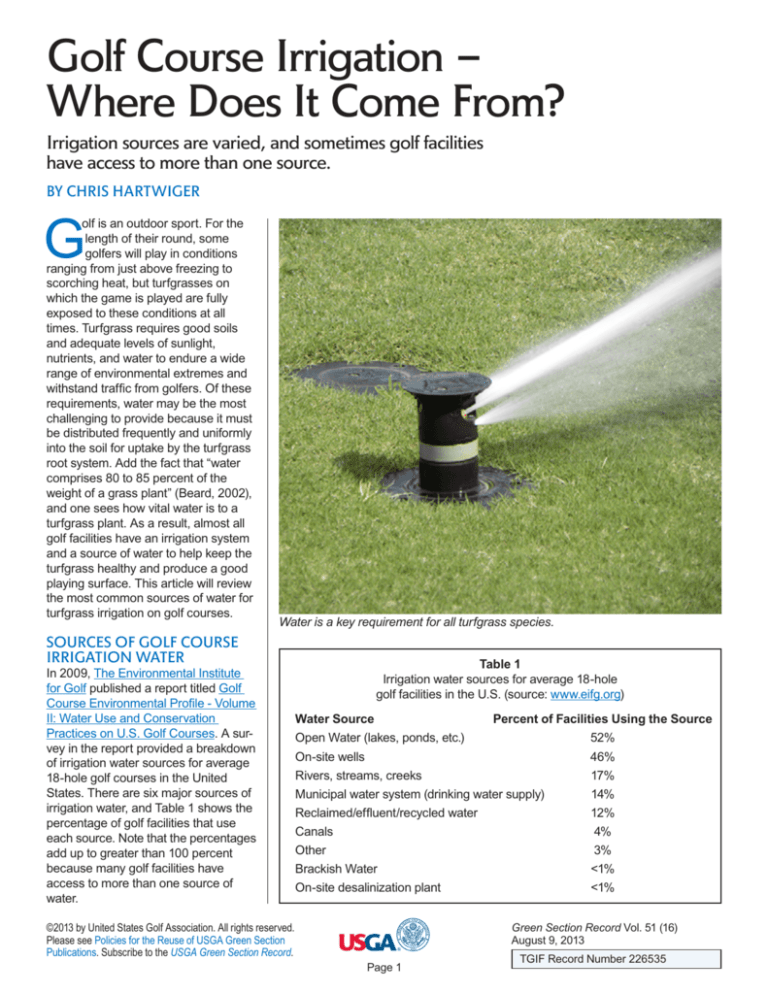
Golf Course Irrigation –
Where Does It Come From?
Irrigation sources are varied, and sometimes golf facilities
have access to more than one source.
BY CHRIS HARTWIGER
G
olf is an outdoor sport. For the
length of their round, some
golfers will play in conditions
ranging from just above freezing to
scorching heat, but turfgrasses on
which the game is played are fully
exposed to these conditions at all
times. Turfgrass requires good soils
and adequate levels of sunlight,
nutrients, and water to endure a wide
range of environmental extremes and
withstand traffic from golfers. Of these
requirements, water may be the most
challenging to provide because it must
be distributed frequently and uniformly
into the soil for uptake by the turfgrass
root system. Add the fact that “water
comprises 80 to 85 percent of the
weight of a grass plant” (Beard, 2002),
and one sees how vital water is to a
turfgrass plant. As a result, almost all
golf facilities have an irrigation system
and a source of water to help keep the
turfgrass healthy and produce a good
playing surface. This article will review
the most common sources of water for
turfgrass irrigation on golf courses.
Water is a key requirement for all turfgrass species.
SOURCES OF GOLF COURSE
IRRIGATION WATER
In 2009, The Environmental Institute
for Golf published a report titled Golf
Course Environmental Profile - Volume
II: Water Use and Conservation
Practices on U.S. Golf Courses. A survey in the report provided a breakdown
of irrigation water sources for average
18-hole golf courses in the United
States. There are six major sources of
irrigation water, and Table 1 shows the
percentage of golf facilities that use
each source. Note that the percentages
add up to greater than 100 percent
because many golf facilities have
access to more than one source of
water.
Table 1
Irrigation water sources for average 18-hole
golf facilities in the U.S. (source: www.eifg.org)
Water Source
Percent of Facilities Using the Source
Open Water (lakes, ponds, etc.)
On-site wells Rivers, streams, creeks
Municipal water system (drinking water supply)
52%
46%
17%
14%
Reclaimed/effluent/recycled water
12%
Canals4%
Other3%
Brackish Water
<1%
On-site desalinization plant
<1%
Green Section Record Vol. 51 (16)
August 9, 2013
©2013 by United States Golf Association. All rights reserved.
Please see Policies for the Reuse of USGA Green Section
Publications. Subscribe to the USGA Green Section Record.
Page 1
TGIF Record Number 226535
result, the need for water supplied
through an irrigation system will vary
tremendously across the country, too.
A reliable source of irrigation water is
vital.
OPEN WATER SOURCES
(LAKES AND PONDS)
Open water sources such as lakes and
ponds can be either natural or manmade. Sometimes they are recharged
by underground springs, streams,
runoff, or wells. Quite often open water
sources for irrigation water also serve
as a key feature in the design of one or
more golf holes.
ON-SITE WELLS
Average annual precipitation from 1971 to 2000 varies widely across the United
States (source: www.prismclimate.org).
RAINFALL
Although Table 1 does not list rain as
a source of irrigation water, it is always
the preferred source on a golf course. It
is free, clean, and distributed uniformly
across the golf course. Unfortunately,
natural rainfall cannot be scheduled
and often delivers more or less than
the turfgrass needs. Arid regions rarely
receive routine rainfall throughout the
growing season, and when it does rain
it can pour, leading to flood events.
Conversely, areas with high levels of
natural rainfall are not immune from
drought conditions. Regardless, natural
rainfall can seldom be the sole source
of water used to meet turfgrass needs,
and every golf facility requires at least
some degree of supplemental irrigation
throughout the year.
Figure 1 shows the average annual
distribution of rainfall across the United
States for the period of 1971 to 2000.
There is tremendous variability in average rainfall totals across the country.
The blue and green areas receive
much higher levels of rainfall than the
areas in yellow, red, and brown. As a
Rainfall is the most affordable source of water, but it is too
unpredictable to be a reliable water source for turf.
Many golf facilities have drilled wells
on property to access irrigation water.
The location or depth of the water
varies tremendously in different parts
of the country. Well depths to ground
water can be as shallow as 20 to
50 feet or as deep as 1,500 to 2,500
feet (Beard, 2002). Well water can be
pumped directly onto the golf course or
into an irrigation reservoir.
RIVERS, STREAMS,
AND CREEKS
Rivers, streams, and creeks are an
excellent source of irrigation water,
assuming flows are reliable. Sometimes water is pumped directly from
these sources onto golf course turf,
and other times it is pumped into an
irrigation reservoir on the golf course.
Many golf facilities have large irrigation reservoirs that are fed
by surface water runoff, wells, and/or natural springs.
Green Section Record Vol. 51 (16)
August 9, 2013
©2013 by United States Golf Association. All rights reserved.
Please see Policies for the Reuse of USGA Green Section
Publications. Subscribe to the USGA Green Section Record.
Page 2
Generally, the smaller the flow and
supply typically associated with streams
and creeks, the more likely it will be
pumped into a reservoir on the golf
course for later use.
MUNICIPAL WATER SYSTEM
Sometimes referred to as “city water,”
water from a municipal water system is
used by some golf facilities for golf
course irrigation. Municipal water is
often easy to hook into and provides
excellent water quality. However, during times of drought, municipal water is
often the first golf course water source
that will be restricted. In terms of cost,
municipal water can be expensive to
obtain, depending on region of the
country.
RECLAIMED WATER
Most reclaimed water is produced from
municipal sewage treatment plants. It
may also be referred to as wastewater,
effluent water, or recycled water. Most
of the reclaimed water used on golf
courses has undergone tertiary treatment, which “produces highly purified
(and pathogen free) waters, especially
if followed by chlorination or ultraviolet
treatment for disinfection” (Harivandi,
1994). Reclaimed water is an excellent
source for golf courses, but often golf
facilities have limited access due to
non-existent infrastructure to get the
recycled water from the treatment plant
to the golf course.
Pricing for reclaimed water varies
by location. In some areas, it is available at no cost, while in other locations
it may be priced the same as potable
water. Further, some reclaimed water
contracts specify a minimum quantity
that must be used. Other contracts
allow a golf facility to use only what it
needs.
The pump station provides the power to push water through irrigation pipes and
eventually through the irrigation sprinklers in each area of the golf course.
CANALS
In coastal areas with high levels of
rainfall, canals are a source of irrigation
for a few golf facilities. Debris, poor
water quality, and high levels of
particulate matter can be challenges
with these sources.
MINOR SOURCES – BRACKISH
WATER, DESALINIZATION
Less than 1 percent of golf facilities use
irrigation water from brackish sources
Some golf facilities have access to fresh water in rivers, but permission to draw
water from the river is required.
Green Section Record Vol. 51 (16)
August 9, 2013
©2013 by United States Golf Association. All rights reserved.
Please see Policies for the Reuse of USGA Green Section
Publications. Subscribe to the USGA Green Section Record.
Page 3
Golf course architects often integrate irrigation sources such as lakes into the design of one or more golf holes.
that must go through a desalinization
plant. Brackish water, or briny water,
contains more salt than fresh water but
not as much as seawater. The high
sodium content in brackish irrigation
sources is not tolerated by most turfgrass species. The desalinization
process often involves reverse osmosis
and, while the quality of water that has
been treated is good, the cost of this
process is high and is not practical for
most golf facilities.
REGULATIONS
REGARDING
GOLF COURSE
IRRIGATION WATER
In the United States, there is no federal
water policy per se, and generally
water is treated as a state and local
issue. Every type of irrigation water
source described above is regulated
by myriad local, state, and federal
regulations. When investigating a
new water source for a golf facility, it
is imperative to seek the counsel of
an expert in this area.
CONCLUSION
Routing and design of a golf course
are heavily influenced by its geographic
location. Just as a golf course in
Florida will look much different from
one in Arizona, water sources are
going to vary geographically as well.
Nevertheless, one thing remains the
same in that turfgrass survival relies
on access to water. So wherever golf
facilities are found, access to a water
source is required.
REFERENCES
Beard, J.B. 2002. Turf Management for
Golf Courses. Ann Arbor Press.
Chelsea, Mich.
Environmental Institute for Golf, 2009.
Golf Course Environmental Profile
Volume II: Water Use and Conservation
Practices on U.S. Golf Courses.
Harivandi, A. 1994. Wastewater Quality
and Treatment Plants. In: Wastewater
Reuse for Golf Course Irrigation. Lewis
Publishers. Chelsea, Mich. pp. 106-129.
CHRIS HARTWIGER is a senior
agronomist with the USGA Green
Section. He appreciates all irrigation
sources, but prefers to avoid them
when playing a round of golf.
Green Section Record Vol. 51 (16)
August 9, 2013
©2013 by United States Golf Association. All rights reserved.
Please see Policies for the Reuse of USGA Green Section
Publications. Subscribe to the USGA Green Section Record.
Page 4







